Growing Blog
Mushroom Grow Bags: The Ultimate Guide
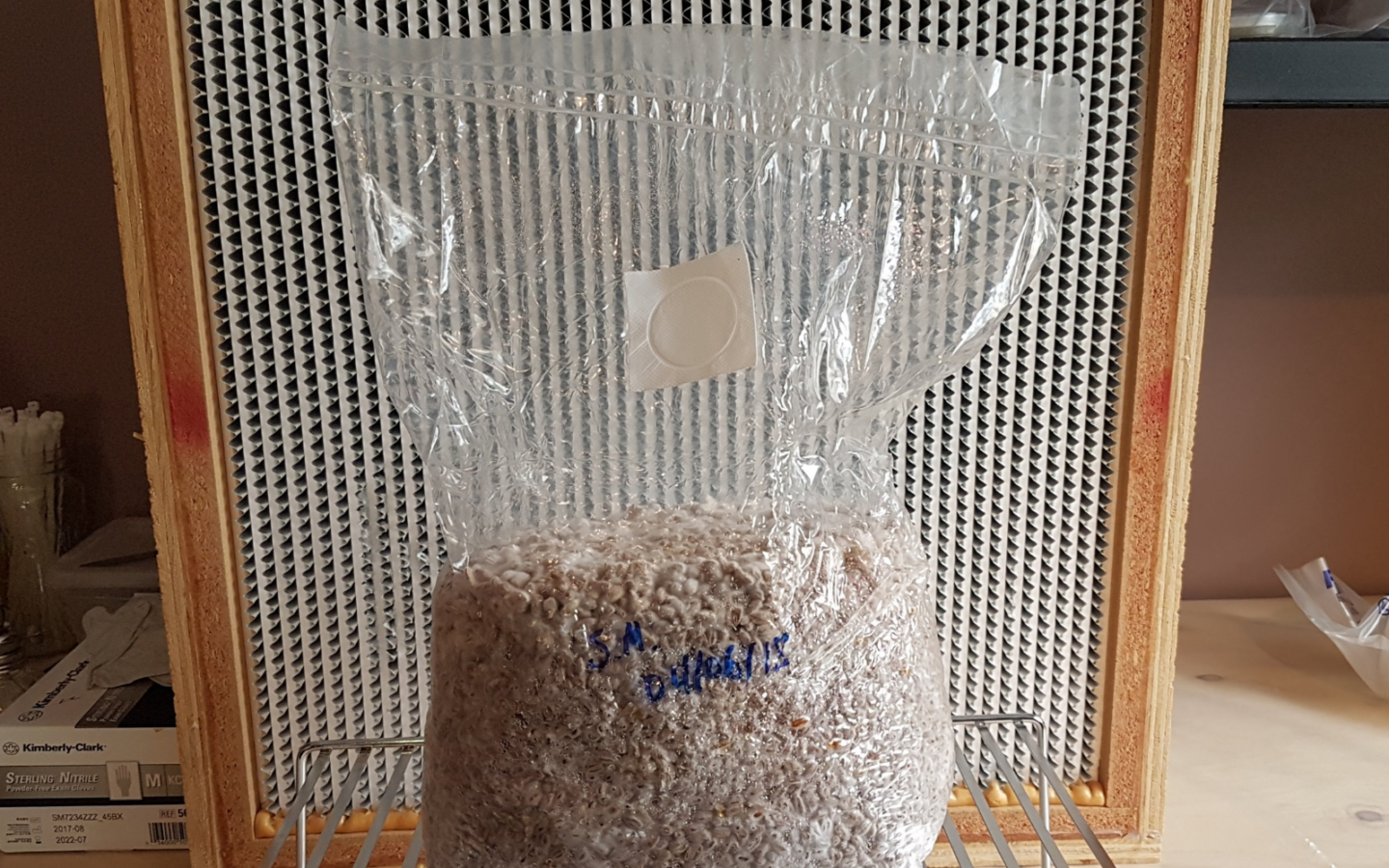
Mushroom grow bags are an essential tool for cultivation, both for the professional cultivator and the enthusiastic hobbyist.
They can be used as spawn bags- in which the bags are used for sterilizing grain and propagating mushroom cultures- or, they can be used to create supplemented sawdust fruiting blocks for growing gourmet mushrooms.
If you’re growing mushrooms, you’ll want to be familiar with grow bags.
What Is a Mushroom Grow Bag?
When someone says “mushroom grow bag” they are usually talking about a gusseted autoclavable polypropylene filter patch bag. OK, I’ll admit, that’s a lot of terms. Let me break it down.

Gusseted
Gusseted simply refers to the way the bag is folded, with the sides of the bag folded flat towards the inside. One reason for this is merely so that the bag folds small and lay flat, yet can open up wide to take on a large amount of grain or sawdust. This shape is also quite useful during sterilization, where the cultivator can slip a filter in between the gussets. This prevents contamination from the air that enters the bag during the post-sterilization cool down.
Autoclavable
Autoclavable just means that the bag is able to withstand the high temperatures of an autoclave, or sterilizer. Typically this is in the form of a pressure canner operating at 15PSI, which subjects the bag to a temperature of about 250 deg F, sometimes for hours at a time. Bags not specifically designed for this would likely melt.
Polypropylene
Polypropylene is the material in which the bag is made out of. It is a “thermoplastic” which won’t melt unless temperatures are sustained between 266 to 340 °F. This makes it an ideal candidate for holding your grain or sawdust during sterilization. A pressure canner wouldn’t see those temperatures unless the pressure got to be over 25 PSI, which is way over the safe limit for home cultivators.
Filter Patch
This refers to the filter on the front of the bag, and is one of the most useful aspects. The filter allows for the mushroom cultures inside the bag to receive fresh air without passing contaminants like mold spores and bacteria. Without fresh air, the mushroom culture would eventually stop growing, but if the bag were just left open after sterilization, contaminates would quickly take over. The filter patch is the perfect solution.
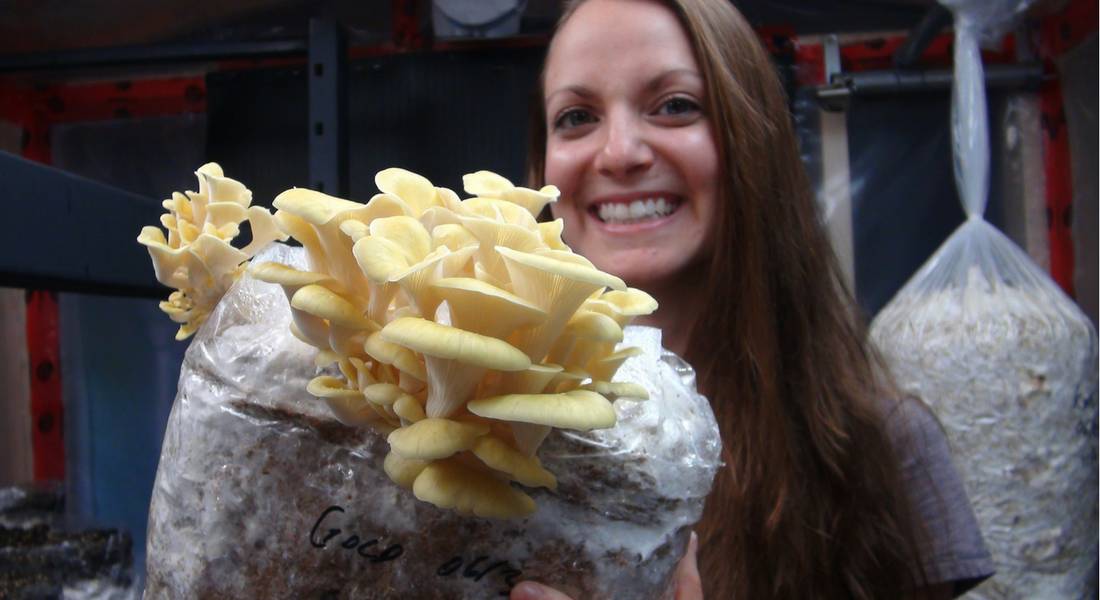
Uses for a Mushroom Grow Bag
There are many awesome ways that you can use mushroom grow bags for mushroom cultivation. The most common uses are spawn bags and sawdust fruiting blocks.
Spawn Bags
Mason jars are useful for making first generation grain spawn, or when only running test batches, but if you are producing large volumes of grain spawn it is much better to use a grow bag. Having your spawn in a grow bag allows you to break up your spawn easily in order to mix it and speed up colonization.
It also makes it easier for spreading your spawn to a bulk substrate.
Anyone who has tried to pull well colonized spawn out of a grain jar knows that sometimes it just doesn’t want to come out. You end up digging it out with a spoon, and risking contamination in the process. Picture trying to get that stubborn ketchup out of a glass bottle. Spawn bags solve this problem.
Usually you can get 5lbs of spawn in a large spawn bag, which, in my experience is a perfect amount. It is enough to spawn a small straw log, or several fruiting blocks. You could even use it to inoculate ten more spawn bags!
Fruiting Blocks
Filter patch grow bags are an indispensible tool for making sawdust fruiting blocks. A large bag will typically make a 5 lb fruiting block, including the weight of your spawn. The bag allows you to easily mix your spawn after inoculation, and the filter patch allows your mushroom culture to breath while it grows throughout the sawdust.
Once your mushrooms have fully colonized the bag, you can either cut the holes or “x’s” in the side of the bag, or cut the top of the bag off entirely in order to fruit your mushrooms. Cutting the bag with the edges at different heights will allow you some fine control over the humidity on the grow block.
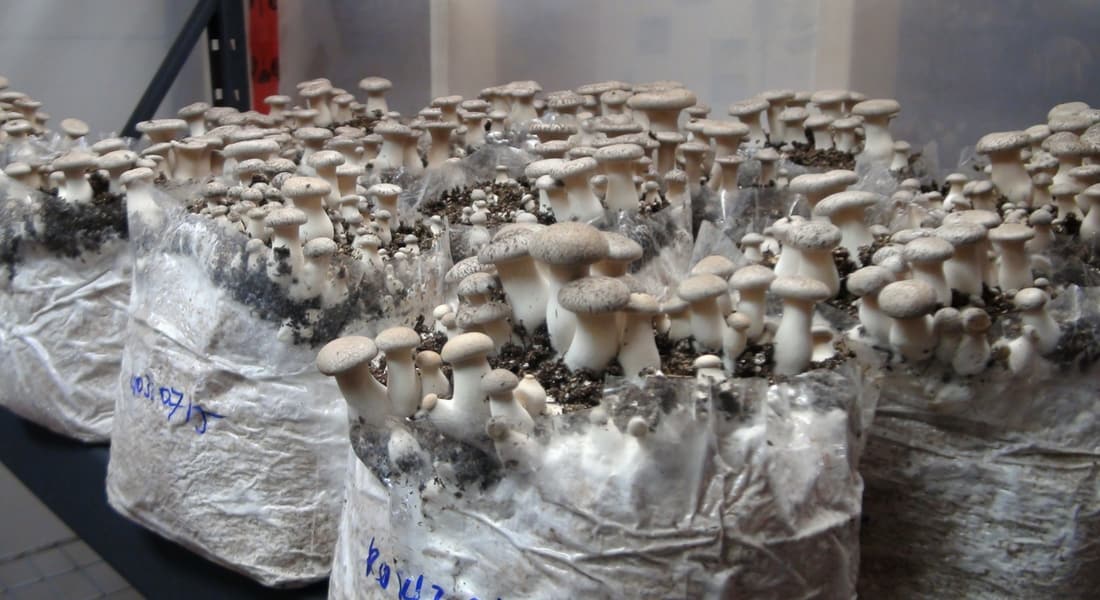
Fruiting in the Bag
Another way to use a mushroom grow bag is to use it as a mini fruiting chamber! The top of the bag creates a humid dome for the mushrooms to fruit. Keep in mind that there won’t be a lot of fresh air inside the bag, so if you are using the bag to fruit your mushrooms, ensure that you open the top of the bag often in order to get adequate fresh air exchange. Ensure that you don’t open the bag until the block is fully colonized, or else your bag is likely to get contaminated.
Some mushrooms will grow inside the bag in interesting ways, notably the Reishi mushroom. In the high CO2 environment of the inside of a bag, the Reishi will grow long and twisted “antlers” instead of the more familiar conk. If you let Reishi grow long enough, it will eventually fruit right through the filter!
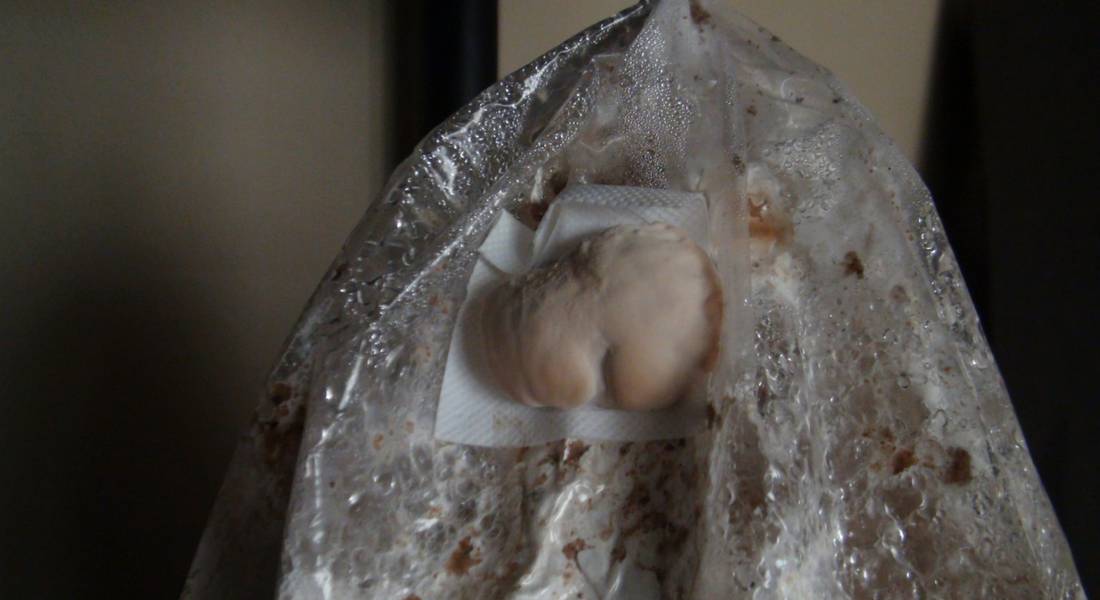
Reuse the Bag
Although you probably want to start with new bags when making fruiting blocks or propagating spawn bags, you can always reuse your bags for other purposes, as long has you haven’t cut the bag open for fruiting.
For example, used spawn bags make for a great container to pasteurize small batches of casing layer on the stove. Simply fill the bag with your casing layer and set it in a pot of hot water on the stove. You may need to place something heavy on top of the bag to hold the bulk of it under the water.
You can also reuse the bag to make mini straw logs instead of using poly tubing. Just fill the cleaned bag with pasteurized straw and grain spawn and you normally would when growing mushrooms on straw.
You could use the bags again for spawn or fruiting blocks, but the integrity of the bag and filter patch decreases after multiple sterilizations, so you are better off using new bags to reduce the chances of contamination.
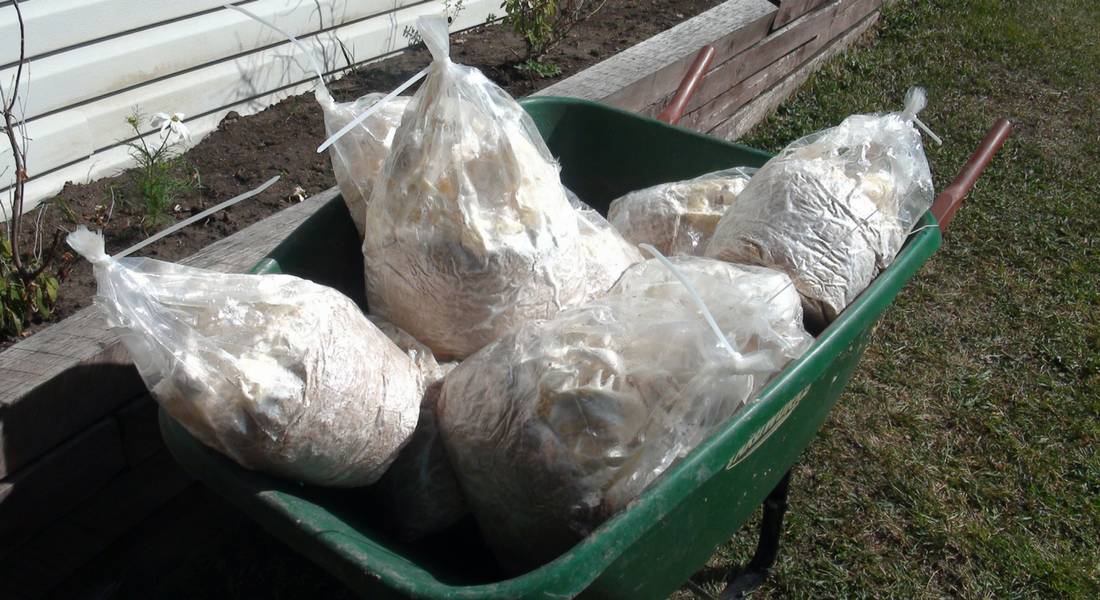
Filter Size
When you purchase spawn bags you need to pay attention to what is specified for the filter. Typically, the filter will be given a micron rating. This simply describes the pore size of the filter. The sizes typically range from 0.2 micron to 5 micron.
If your bags are to be used for fruiting blocks or spawn bags, you’ll want to shoot for a small micron rating, no higher than 0.5 micron. This will be required to adequately protect your substrate from contamination.
Mushroom bags with a 5 micron filter will allow for more gas exchange, but will likely lead to a much higher contamination rate and are not recommended for sterile cultivation.
Bag Size
These bags are generally available in a variety of sizes. The size of bag you want obviously depends on how much substrate of grain you want to put in your bag, and other factors such as the size of your sterilizer.
In my experience, the large sized bags are by far the most useful. To give you an idea, a bag of size 8 inches wide by 5 inches deep by 18 inches tall will comfortably hold 5 lbs of supplemented sawdust and grain spawn. You can just fit 6 of these bags in a Presto Pressure Canner.
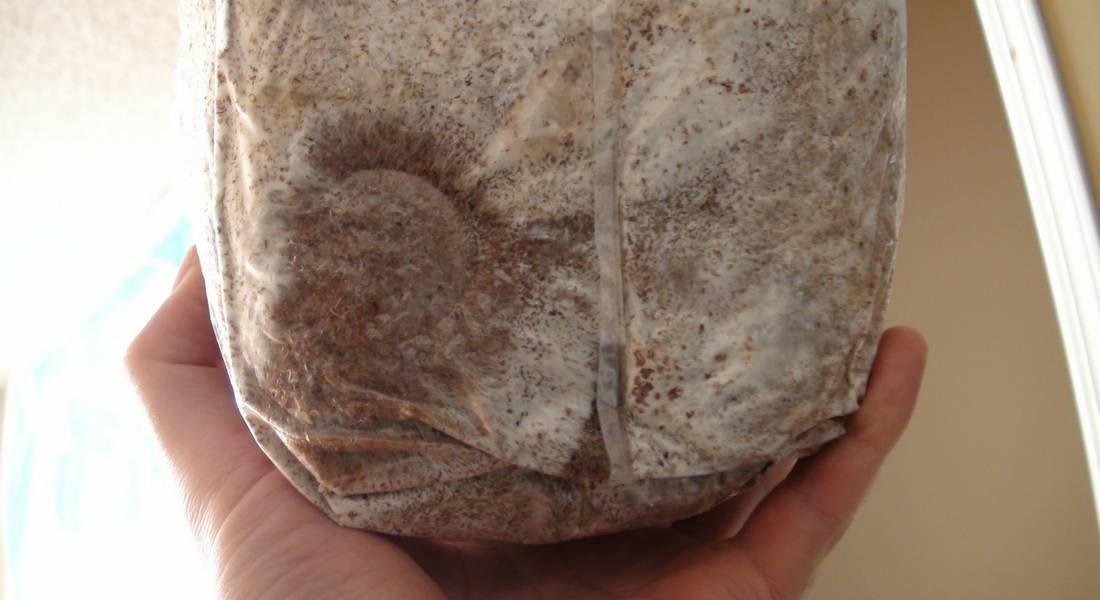
Material Thickness
The bags come in a variety of different thicknesses, with the typical range being 2.2 mil to 4.0 mil. Bags of thickness 2.2 mil work fine, but you can expect a small percentage of your bags to rip during normal handling.
If your bag rips post-sterilization, there is good chance that your bag will get contaminated. Thicker bags are less likely to tear, but come at a higher price.
My recommendation would be to go with thinner 2.2 mil bags, and take reasonable care when handling your bags.
Using a Filter Sleeve
A good trick to know when using grow bags is how to use a slip-in filter to prevent contamination during post-sterilization cool down.
After sterilization, as the bags are returning to room temperature, room air will naturally be drawn into the bags. If this air is not filtered properly then there is a risk of contamination before you even get a chance to inoculate your bags.
In industrial mushroom farms, this problem is eliminated by allowing the bags to cool down in a clean air environment. Often the autoclave will be cooled before it is opened, and the air is drawn in through a HEPA filter on the outside of the sterilizer.
This is not that practical to do on a small scale. The way around this is to slip a small cloth filter into the bag between the gussets before sterilization. Tyvek works great for this. You can even use cut up pieces of a painter’s suit, which can be found at any hardware store or on Amazon.
The filter should go between the gussets above the substrate. Make sure the inside walls of the bag are clean before inserting the filter. Then, simply fold the bag over a couple times and load it in to the sterilizer. There is no need to seal the bag before sterilization.
Any air drawn into the bag during cool down will be passed first through this tyvek filter. Simply pull the tyvek sleeve out after the bag cools off, and right before inoculating your bag. I have used this method with almost a 100% success rate.
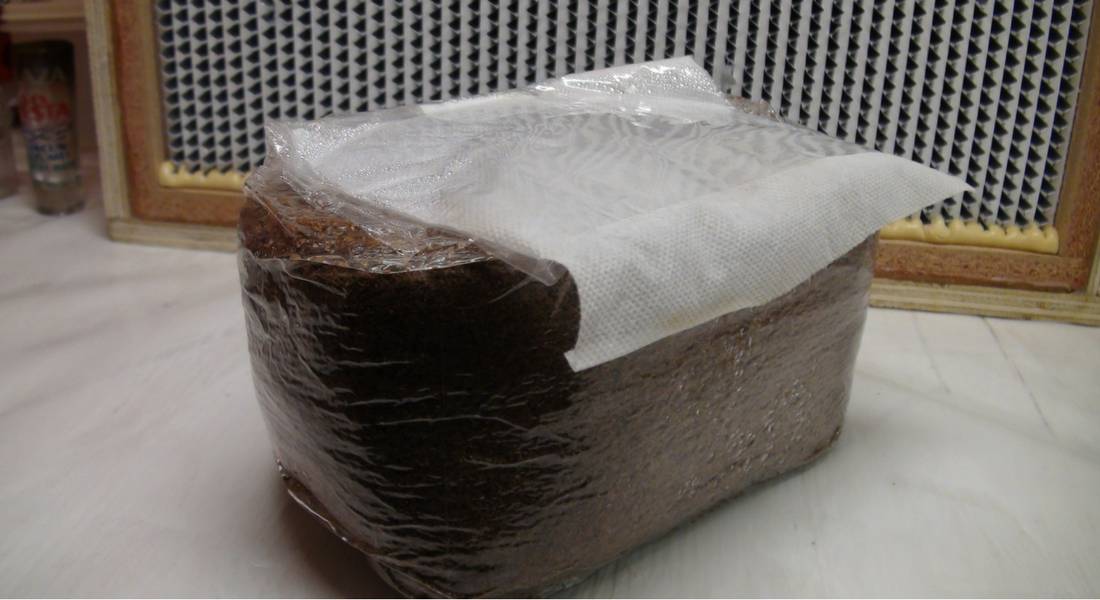
How To Seal a Mushroom Grow Bag
After you inoculate your grow bag, you’ll want to seal the top before you set it on a shelf for colonization. There are a couple easy ways to do this.
The simplest method is to use small pieces of wire.
After inoculating the bag with your spawn, quickly twist the top of the bag and tightly wrap the the wire around the twist. You can use something like this, or any steel wire found at your local hardware store. You could also use zip ties, which are quick and easy but much less cost effective.
Of course, you could always step up your game and use an impulse sealer. If you are pumping through a high volume of bags, an impulse sealer will save you some time and effort, but for small scale grows, it is likely not worth the cost.

Biodegradable Grow Bags?
One concern about using mushroom bags, especially for large scale commercial operations is the environmental cost. Polypropylene bags are not all that environmentally friendly, and after a short while end up being a huge amount of waste.
Some growers are investigating using biodegradable mushroom bags, although there is nothing currently commercially available that can compete with the effectiveness and utility of a autoclavable polypropylene filter patch grow bag.
Best Mushroom Grow Bags
There are plenty of places that you can find grow bags online, although most of them come from a just a handful of small suppliers in China.
If you are looking for large volumes of bags (1000 or more at a time) check out Unicorn Bags. They have all types of bags, in every size and shape, and all different filter sizes. I haven’t personally ordered from them, but they have been around for a while and many growers use them with success.
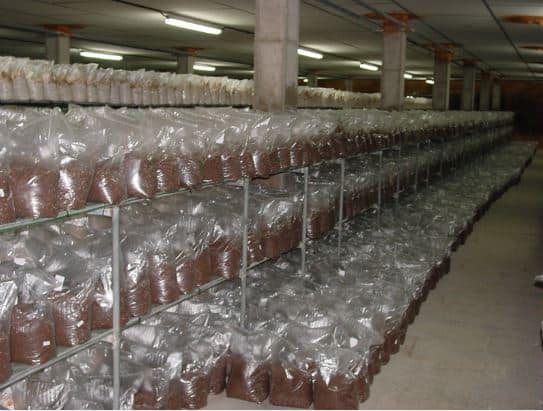
Mushroom grow bags colonizing en masse, from unicornbags.com
If you are looking just to get a smaller quantity of bags you can find them on Amazon here.
Good Luck With Your Bags
This may be more information than you ever wanted to know about grow bags, and if you read this far you just may be mushroom grower! Let me know in the comments below if you have any other questions or need any more clarification.
As always, best of luck with your grows!
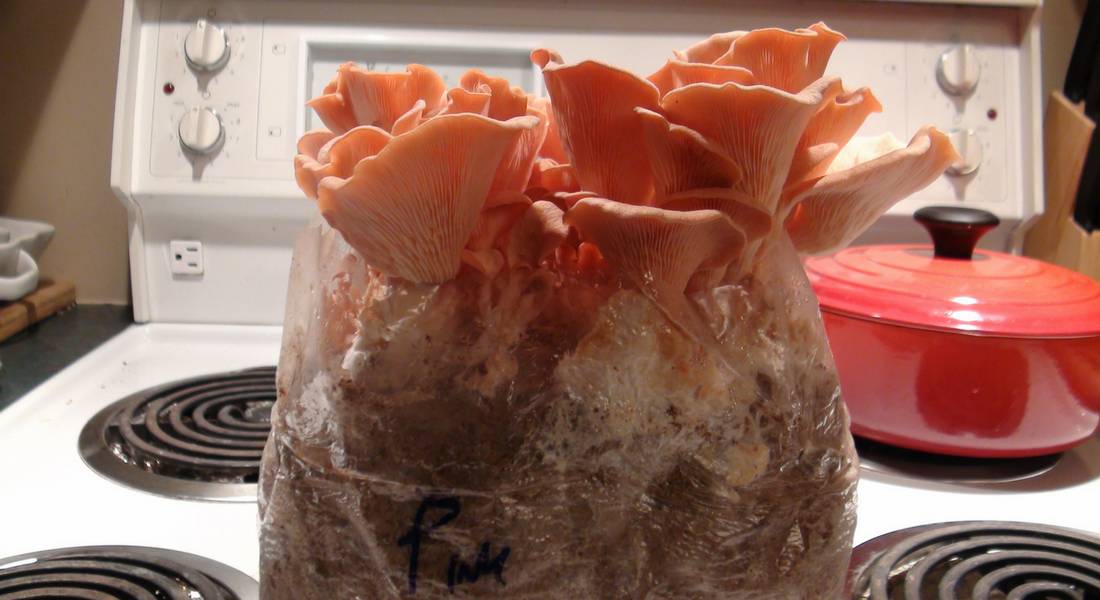

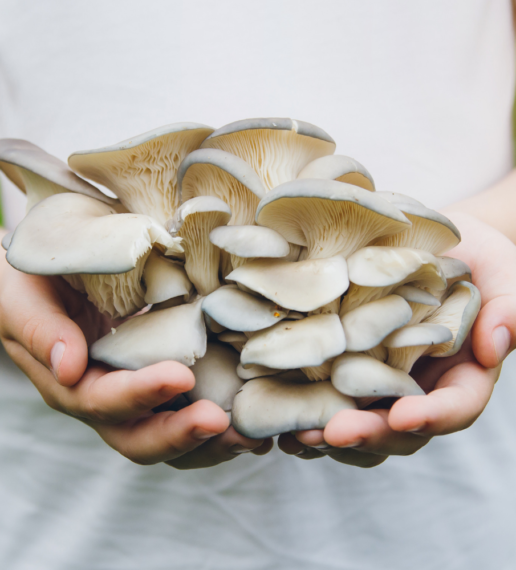
Can you use coffee grounds mixed with the hardwood sawdust If so , how much coffee to sawdust? How wet should the sawdust be before bagging and pressure cooking, and how long should you cook it at 15 Lbs pressure. Would this work for spawning bags and or Spawn for inoculating straw logs?
Thanks Danny
Hi Danny. Thanks for reaching out! Yes, you can definitely use a mix of sawdust and coffee grounds to grow mushrooms. Depending on what type of mushroom you are growing, you can use a fairly high ratio of coffee/sawdust. Personally, I would treat coffee grounds as a supplement, and use it sparingly, at around 5-10% wet weight compared to sawdust. Getting the right amount of moisture in the sawdust definitely takes some practice. For each 5 lb fruiting block, i generally use about 1.5 liters of water- but you may have to experiment yourself.
The sawdust should be moist but not dripping wet. You should be able to squeeze a couple drops of water out if you grab a handful and squeeze really hard.
You should pressure cook at 15 PSI for about 2.5 hours to ensure all the contamination is removed. Same pressure and time for spawn.
I have not used coffee grounds in spawn, but have used a little bit of coffee while soaking the grains. I am honestly not sure whether or not it makes a big difference, and you are likely better off leaving coffee out of the spawn in my opinion.
Good luck!
Great advice. I’ve actually grown mushrooms (Pleurote) in pure coffee grounds. Basically I had a friend that could give me all used grounds from a coffee shop. Mold grows super fast on it, so I would pick up daily and freeze it between autoclave sessions. On pure coffee grounds, mushrooms grew no problem. Absolutely no coffee or different taste in final product. BTW I never even adjusted the PH of the grounds, since I lack the device to test.
HI Tony, When sterilizing the substrate in a pressure cooker, do I have to cover the filter so it does not get too soaked? I guess, after sterilizing the substrate, one inoculates it with spawn. Is there a technigue of using the substrate with the spawn? Do I have to inoculate in a sterile area. I bought saw dust spawn from a reputable manufacturer. What is the ration between sawdust spawn and the substrate?
Danny
Hey Daniel, thanks for reaching out!
If you are using grow bags, make sure that the water level in the pressure cooker is lower than the height of the filter- that way you don’t have to worry about the bags getting soaked. 3-4 inches of water in the pressure cooker is probably fine, depending of course on the size of the canner. I usually like to put jar lids or something underneath the bags to hold them off the bottom of the cooker which will allow you to add more water without hitting the level of the filter. Make sure that you watch you cooker closely the first couple of times you sterilize so you can be sure it doesn’t run out of water. You don’t want to run a canner dry.
Yes, it it best if you add the spawn in a sterile area, especially if your substrate is supplemented with oat bran or similar. I usually like to innoculate in front of a laminar flow hood, but if you do not have one, you can consider using a “still air box” essentially a tote with arm holes that you can clean and inoculate the substrate by sticking your arms in the box. Just think about potential ways that mold spores or other contaminates could find a way into your substrate- and try to mitigate those… ie clean hands, minimum time with an open bag ect…
Add sawdust spawn at about 10% ratio- the higher the ratio, the better chances you have for a contaminate free grow.
Hope that helps!
Tony
I wa s wondering if it is possible to mix up my substrate to field capacity, followed by sterilization. Is it possibleto then, seal the bag, and add my spawn to it at a shortly later date, somewhere around a week or so??
Sure that should work! If your bag is sterilized and properly sealed it should stay sterilized until you are ready to inoculate it, even if it is a week later.
Tony, great article!
Something I’ve been having a hard time finding out: After harvesting, can the fruiting block be allowed to continue to grow fruit, or after each harvest does another fruit bag need to be made? If the former is the case, for how long/how many cycles can this growth continue?
Hey Makoto!
Most of the time, you can just leave the bag after harvesting… no need to make a new one. Leave it in fruiting conditions and a new flush will come. The exception is Shiitake, which needs a rest period, where the block is dried and re-hydrated.
Hope that helps!
Hey, thanks for all the info.
Using Unicorn Bags and a heat sealer seems to be the standard of this business, but I wonder how effective it would be to use simple gusseted polypropylene bags without filter and a polyester fiberfill plug on the top instead.
Unicorn bags cost 4x times more than the same type of bag without filter, they got the whole market cornered.
Right after inoculation instead of using a heat sealer, the plug would be placed and tied with wire. The process wouldn’t take longer than the standard method. How do you think this would work? Cheers
Anything that filters the air is going to help, but the pores should go down to at least 0.5 microns to capture the majority of air-born contams like bacteria and fungal spores.
Great article! This might be a silly question, I may just be missing it…
Do you add spawn after the substrate is sterilized or do you sterilize substrate with the spawn mixed in already?
Also, with fruiting blocks are the plastic bags removed completely so mushrooms sprout all over?
Hey Jaron! That’s a perfectly fine question. You need to add the spawn after the substrate has been sterilized, otherwise the spawn would definitely die from the heat. As for removing the bags, no in general you only want to cut off the top, with the exception of shiitake in which case you remove the whole bag.
Hope that helps!
Tony
Hi Tony. Would you know if there would be a difference in yield if we use smaller fruiting bags (holding 800 g substrate) instead of huge cylindrical blocks (upwards of 5 kg substrate)? Also, I’m looking for eco friendly solutions. Do you have any experience in using reusable containers instead of plastic bags? Is there a difference in yield? Thanks!
Hey Ella! Yes, there should be a difference in yield, although I do not have hard data on the subject. Mushrooms do need a threshold level of substrate to fruit. A 10 lb bag can very likely give a higher yield- but it will depend on so many factors, and you just need to experiment to see what works. I have been experimenting with bottle cultures for lions mane, expect a new blog post soon!
Hi Tony,
I have filled polythene bags with chopped wheat straw after proper sterilisation. But have forgot to punched holes in the bag for fresh air at the time of filling bags. I had punched holes after approx. 60 hrs of sealing bags. What impact it will have on my mushrooms?
If you use the filter bags, you do not need to punch holes, since sterile fresh air exchange will be available through the filter. Hope that helps!
I was wondering if polyethylene is also sufficient to use as grow bags
thank you
Hey Tony!!
I stumbled across this website in search of information, and I believe I came to the right place!
My question is,
Im using Spawn bags. But I was wondering instead of growing in the bags at all, and no casing/bulk mix.
Just simply, having (2) 100% Colonized Mycelium blocks in my Fruiting Chamber. Which consists of a self Humidifier, and Fresh air exchange. Would it be allowable to just fruit the entire Spawn bag block? And after the first flush, Dunk the block, and possibly roll in vermiculite to hold moisture, and return it to the fruiting chamber? I’ve seen this method used with glass jars, but wondering if it can be done with the Bag containments.
Would there be any Pros/Cons of this?
Thanks Tony,
Looking forward to your knowledge.
Sincerely,
Nick.
Hey Nick!
Yes, you can just fruit from the spawn blocks, but to be honest, you are way better off making a proper fruiting block. Mix up hardwood sawdust and bran, get to the proper moisture, sterilize, and inoculate- you will get much better results that simply using the grain spawn. And don’t worry about rolling in vermiculite. Just keep the bag on, and poke little “x’s” in the sides where the mushrooms can grow through.
Hope that helps!
Tony
Hi Tony!
We are just getting started on our mushroom growing venture. We have the grow house set up and ready to go. I’m so excited! I’m still a little confused on how you use the Tyvec suits to prevent contamination. Also are the suits reusable or is it a one time use. While I am asking where do you get spawn and how do you purchase it? There are so many ways that you can order it, I am a little overwhelmed with which will be the easiest for us to use to get started.
Thanks in advance for any insight that you can give me.
Toni
P.S. Great name by the way! 😉
Hey Toni!
Don’t worry about using the tyvek suits. This can help, but is not necessary. I have been sterilizing blocks without it for a while now, with great results.If you do use it though, it is entirely re-useable. We actually sell our spawn, so you can get it right from FreshCap- check out the store. Thanks for stopping by the site and best of luck in your journey!
Hello Toni!
One simple question:
In the video in which you explain Growing Mushrooms On Sawdust: Making The Fruiting Block, you say that you use for each 5 LB fruiting blocks, 5 cups hardwood pellets.
My question is, how much is it your “cup” measure?
Hey Marcio! 1 Cup is ~250 ml, so five cups should be 1.25 liters.
Hi Tony,
Great article, great site! Thank you.
I’m interested in a reply to Pedro’s question (Jan 13th) above. I would like to know of alternatives to filter patch bags. How does one get air exchange if you’re not using a bag with a filter?
Many thanks,
Tamra
Hey Tamra! I’m glad you like the site!
If you are using a low-nutrition substrate, you can use any container with holes, like poly tubing with holes poked in it, o re-usable 5 gallon buckets with holes drilled in. This works for growing oysters on pasteurized straw.
If you want to use more nutritious substrates, like supplemented sawdust, you can grow in bottles or mason jars. I will do a write up about this soon, but basically, the jars can look very similar to grain jars, with a hole in the lid stuffed with pillow stuffing for air exchange. You leave a hollow center in the substrate before you sterilize so that you can inoculate the substrate by filling up the hole with spawn in a sterile environment. Hope that helps!!
Your great thank,u ✌️
Hi, Tony!
What would be the best way to store fruiting blocks that are not quite ready for fruiting? Would covering them with a blanket and placing them in a cool place good enough?
Hey Michael! Yup, either that or put them in the fridge. I an store fruiting blocks in the fridge for months at a time before taking them out to fruit. Works especially well with King Oysters, Blue Oysters, and Lion’s Mane.
Hello Tony!
I use polypropylene bags with a plastic ring and cotton as filter. There are some blocks of reishi that are still in the colonization stage but the mycelium grew through the cotton plug. I want to know if there is any problem if the mushroom bears fruit that way.
Thanks!!
Nope, in fact I have had that happen myself! Reishi is tenacious, and can rip right through filters. It will likely just grow into a nice fruit if in the right conditions.
Thank you for imparting your wisdom. I just sterilized my first 5lb block of Master’s Mix today. Gonna be inoculating them with some Golden Oysters and one with Lion’s Mane.
What would happen if you inoculated one substrate with two different species??
Glad you liked it! Good luck with the masters mix 😉
If you inoculated one substrate with two species, they would likely duke it out, and the stronger one would win. I guess they could also take sides and fruit in different areas of the substrate. Could be a fun experiment to try!
Hi, thanks for posting all this great info all through your blog. I am just starting out with several varieties.
My question is about “slipping the filter between the gussets”. In the photo you posted, I cannot see a filter. Maybe I am just missing it. Can you please explain how and exactly where to place such a thing? A really clear photo would be awesome.
Hey there glad you like the site! About the filter- you can definitely skip this step. I initially did it because it would help filter the incoming air as the bag is cooling. The best bet is to just fold the bag over the block. I have done this for a long time now, and have 0 contamination. No filter required! If you are still interested, email me directly through the contact page and I can send you a picture, but again, not needed. Happy growing!
Let me just say you’re doing a wonderful job with this site. Your help is invaluable to the novice growers thinking of getting into this. My question is one that I’m sure many growers have not thought of. Are there any regulations/certifications needed to grow mushrooms for human consumption? If so, is it regulated by each individual state? Thank you in advance for any help.
Hey Carla! Glad you like the site 🙂
Yes, these rules will vary from state to state, province to province. You need to check with your local regulator and they should be able to help!
This article has been one of the most helpful I’ve read online. Great information.
Question though.
I’m using the grow bag as a fruiting chamber. The growth is slow or close to zero. What is growing seems be coming from the bottom edges and sides. It seems like it has the most moisture there.
Does this mean I should be misting more? I’ve been fanning once a day as instructed but perhaps it needs more FAE?
Any input would be greatly appreciated. Thanks!!
Hey Tony, can you explain the part of the filter sleeve again? I’m having a real hard time wrapping my head around how to insert the filter between the gussets. Can you explain how how big (like dimension wise) the Tyvek filter is and if it’s folded or anything. I’m using 18×5” bags like you so should I take a cut piece of tyvek 8”x5” and slip it in the bag down one gusset side 4” then fold it over and put the other 4” down the other gusseted side (making sort of like a dome)? Or am I just simply sliding a 5×5” piece of tyvek down one side of the bag in between the gussets then folding the bag a bunch of times? Thanks for your help! Ps I’m planning a switch from jars to bags and want to have it all planned out before I start.
Hey Bobby! I wouldn’t worry too much about the filter sleeve. Stopped using it quite a long time ago and haven’t noticed any issues. Just fold the top of the bag over and make sure the blocks are cooled down before removing from the pressure canner.
Hi Tony,
I am having problems with bags expanding and blowing holes in the side. I have insulated them from touching the side of the PC. Holes sometimes show up in a little gap between the bags near the center of the PC. My latest effort is to fold th bag in a way that lets the filter be used as a vent of sorts. This “may” be helping, but to early to tell.
Any thoughts? And thank you so much for this great write up!!!
how much of the substrate do you normally add in a 6×10 polypropylene bag?
I have moved from buckets to grow bags. My question is when to fruit. I am growing grey doves and the bags are fully white all around (with some gelatinous buildup) but not on the bottom. Several videos say fruit from the bottom of the bag. When is the right time to fruit? Also, do you find fruiting out of the top, bottom or the sides is better? These are on 7lb sawdust blocks. Thanks for lots of great info for rookies like me. JG
Thought of one other question. Can you stagger the fruiting? Example, can I make 4 sawdust blocks but start fruiting them at different times so as to not have 20lbs of mushrooms at once and enjoy fresh mushrooms for a longer period?
Hi. Thank you for the detailed write up. Since I can’t get my normal bags I’m looking into a few source and I’m curious, which filter size (.2 or .5) would you recommend for growing Ganoderma antlers, and would you use the same size filter if you were going to cut a slit in the bag and try for conks? Thank you!
I’m just a little worried the .5 micron filter bags might allow for too much GE which might cause the block to form antlers with my g.multipileum (since it likes to form antlers in vitro super early) before I can zip tie the bag and make a slit in the side of the block.
Hi Tony,
I know you published this a while ago, hope you see it. For sawdust/bran or masters mix substrate, do you sterilize or pasteurize? What are the specs of your sterilization process in regards to temp and time (not talking about grain spawn)
How can putting a piece of tyvek in the top of the bag work as it is only in one gusset the other has nothing in or do you use two and put it in an x wing configuration
Hey! Quick question. Im growing King Oysters off fruiting blocks. You have a pic in this article of King Oysters growing off fruiting blocks and I was wondering why the top of those blocks look like they have a type of soil spread on them? Is it a nutrient layer you add after pinning or something? Just curious and wondering if it’s necessary. Thanks to anyone who can answer. 🙂
Hi Tony, when using a grow bag, is it okay to keep the mushrooms fruiting in the bag all the way until cultivation, or do you take them out of the bag and transfer them to a tub of some sort when you begin to see growth? I’ve read and seen conflicting things and want to make sure and do it right!
Hi, I’m Randy and I have a problem with my grow bags. I use three layer grow bags, with grain on the bottom, straw in the middle and horse manure substrate on top. The problem is the mushrooms are growing in the straw layer and not on top. Should I cut my bag around the straw layer or leave it be ??
Thanks Tony for all your information on growing! So many new growers, like me, get started using your blog, why don’t you sell some of the things we need like the mushroom bags with filters, or even sterile, bagged substrate? I make my own spawn, but I’d love to skip the pressure cooker and buy sterilized substrate. I can buy those things online but since you are doing all the teaching I’d rather support you with my purchases.
Hey!!! I have been colonizing grain in jars (from liquid spores) it’s ready to go.. I’m transferring into 5lb grow bags using your for substrate rec.. but I’m unsure from 1 quart mason jar of spawn can we used for how many grow bags?
tony, so I inocuylate the grain which is on the bottome of the bag. When the mycelium if all white, I break up the grain and mix in the substrate and then wait?